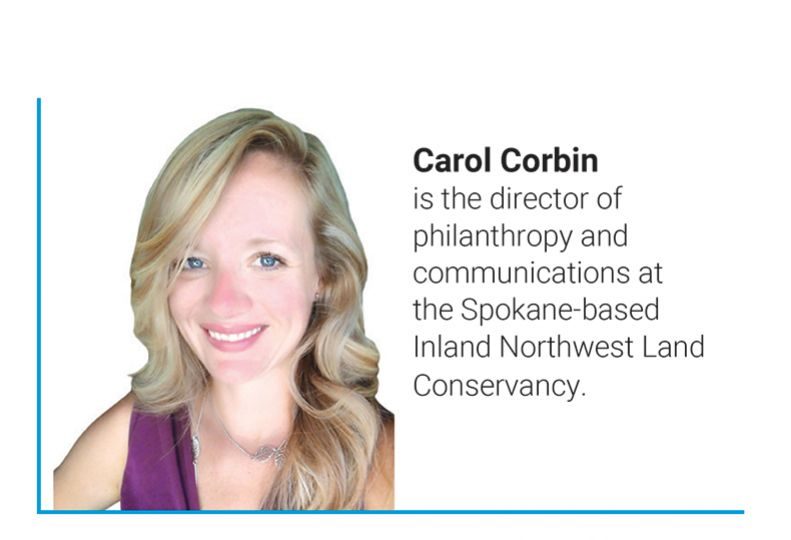
Home » Conservation isn't economic development's nemesis
Conservation isn't economic development's nemesis
Quality of life must be measured by more than price per square foot

June 16, 2022
Seventeen years ago, as a recent college graduate and lifelong East Coaster, I rolled into Spokane with only what would fit in my tiny SUV. And now, as thousands of people move to the Inland Northwest from Seattle, Colorado, and California, I feel like an early adopter, fortunate enough to have stumbled upon “Near Nature, Near Perfect” by accident.
The Inland Northwest is in the midst of a migration boom right now. Economic changes in urban centers resulting from COVID, climate changes in drought-beleaguered states like California and Colorado, and many other factors are drawing people to communities like ours for the low cost of living and quality of life that comes from things like immediate access to the outdoors.
This rapid growth brings with it a direct tension between the work of conservation—protecting natural spaces on behalf of wildlife, plants, clean water, and clean air—and the work of economic development. And while many, even in the conservation community, would cast this narrative with economic development as the antagonist, the story isn’t that simple.
Thirty-one years ago, a group of passionate individuals saw the writing on the wall. Recognizing that it was only a matter of time until this place was “discovered,” they set out to form a land trust—a registered nonprofit that works with landowners to set up permanent legal agreements prohibiting things like residential and commercial development, clear-cut logging, and wetland removal.
Quietly working to protect places in seven Inland Northwest counties, Inland Northwest Land Conservancy has now preserved over 23,000 acres, including 125 miles of waterways. Growing from a staff of two only five years ago, eight people now work to identify important places, engage communities in the outdoors, work with landowners to put legal agreements in place, and steward lands already under our care.
Where once we took on land protection projects based primarily on interest from landowners, we now have a data-centric tool that considers a multitude of factors, including wildlife habitat, water quality, species migration, intact forest land, community value, imminent threat, and climate resilience. This tool helps us decide the most important and immediate opportunities to protect places important to this region.
We rely on relationships cultivated over the last three decades. That involves trust and collaboration with local land managers, elected officials, tribal leaders, private landowners, and ecologists to negotiate permanent protection and public access to these special places, where possible. This is all in support of our vision, a future of interconnected natural habitats throughout the Inland Northwest, supporting thriving populations of native plants and wildlife, respected, and enjoyed by all who call this region home.
Increased concern about wildfires, thousands thronging into the woods and trail systems during COVID, and an endless march of economic and climate migration have engaged the public mind in the work of conservation in ways this community has not seen before. Families, business leaders, educators, and elected officials are eager to find ways to preserve our way of life while continuing to foster the growth of local businesses, a dynamic and healthy economy, and a vibrant arts and culture scene.
In many environmental stories, economic development is cast as the villain. Developers bulldozing meadows to put up condos. Suburbia gobbling up farmland. Trees being cleared from the sides of mountains for vacation homes. Wetlands drained for strip malls. But a story like this lacks dimension and creativity. It feels stiff and wooden, and not all like the story of who we as the Spokane community are or hope to be.
In 1974, the World’s Fair in Spokane was themed around protecting the environment, connecting deeply to place, and making that connection a part of our collective identity. And almost 50 years later, this is still true. Even transplants like me are here because we love the outdoors, nature, wildlife, the simple joy of getting our hands in the dirt or our eyes to the clouds.
I would venture to say the antagonist in our story is disconnection from nature, an absence of experience with forests, rivers, butterflies, and fish. And defeating this villain takes all of us working together—businesses, developers, elected officials, and the public making a clear statement that a connection to land and water, and the health and vibrance that comes from that connection are endemic to who we are as a community.
If the “end” we hope for is personal profit at any cost, then we are a community in which conservation has no place—a community in which the value of place is price per square foot. But if we look in the eyes of our children, breathe in clean air, drink the cold, clear water from our aquifer, listen to springtime songbirds, and decide that the “end” is, instead, health, happiness, connection, and community, then conservation of wild, natural spaces must have as significant a place in our story as economy, infrastructure, education, and health care. The protection and re-creation of our collective connection to this place is our future.
Latest News




![Brad head shot[1] web](https://www.spokanejournal.com/ext/resources/2025/03/10/thumb/Brad-Head-Shot[1]_web.jpg?1741642753)